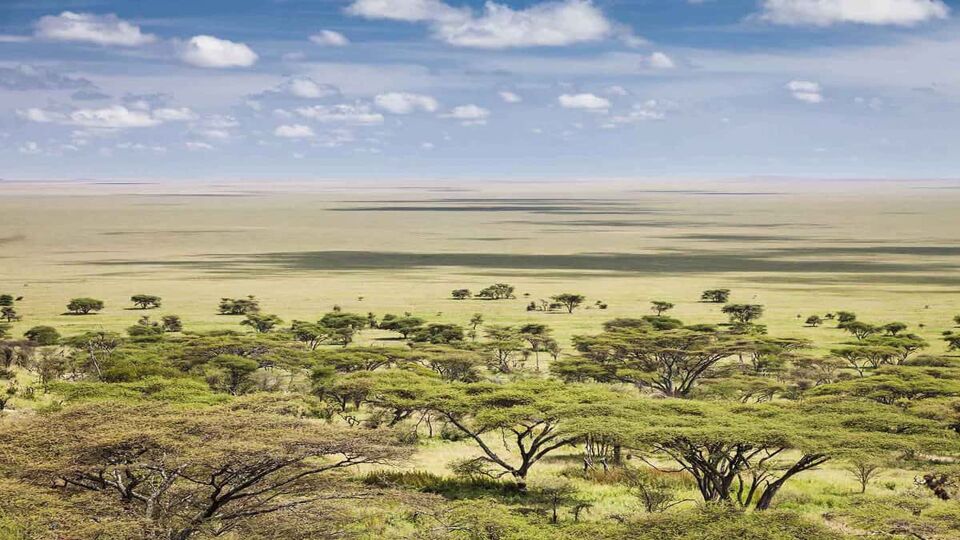Moshi
Price $1,282
Min age 1
Rating 4.98 / 5 [59 ratings]
Tour supplied by:
Bucket list destination:
Serengeti National Park, Mara Region, Tanzania

The Masai’s name for this area, Siringitu, says it all: “The place where land moves on forever”.
This Tanzanian reserve is vast: 15,000 square kilometres, and because it hasn’t changed for millennia, the game experience is totally authentic, and the annual great migration of over two million creatures in search of food and water still one of the greatest wildlife spectacles on earth.
Vistas are primarily grasslands, with areas of savannah, and rocky kopjies into which most accommodation is built – from palatial lodges to simple bush camps.
The Park is located in Tanzania, just south of the equator and Kenya’s Masai Mara National Park, with Lake Victoria to the west.
Because the reserve is so large, its geography is extremely varied: from the famous vast African grasslands fringed by woodland rising to hills dotted with enormous volcanic boulders.
The south is the most frequently visited and where the migration calves around March; the northern reaches are less visited and equally beautiful, turning into the Masai Mara in Kenya, just over the border.
Our selection of the best Viator tours of this destination, plus helpful tickets and transfers
Moshi
Price $1,282
Min age 1
Rating 4.98 / 5 [59 ratings]
Tour supplied by:
Arusha
Price $1,240
Min age 6
Rating 4.95 / 5 [48 ratings]
Tour supplied by:
Moshi
Price $3,050
Min age 3
Rating 5 / 5 [29 ratings]
Tour supplied by:
Moshi
Price $4,974
Min age 3
Rating 4.92 / 5 [25 ratings]
Tour supplied by:
Kilimanjaro
Price $3,143
Min age 18
Rating 4.6 / 5 [10 ratings]
Tour supplied by:
Tanzania is a year-round destination, with daytime temperatures ranging between 20C and 35C. There are two rainy seasons: the long rains, from about March to May, and the short rains in November and December. Most visitors come from June to October, although these dry months are the most expensive. In April and May in the southern Serengeti, game is plentiful, herds are calving and prices are low, so if you don’t mind getting wet every now and then, it can be a great time to go on safari.
December to July sees the great migration in the south; June to October in the north and, if you are lucky, the famous wildebeest crossings of the Mara River.
Kilimanjaro International, just outside Arusha, receives domestic carriers from Dar Es Salaam and Nairobi. From there, the fastest way into the Serengeti is by light aircraft, to either Seronera airstrip in the heart of the Serengeti or Kirawira airstrip in the western corridor. The alternative drive is interesting, but long: passing the gate of Lake Manyara National Park, going up the Rift Valley Escarpment, through communal farming lands to the Ngorongoro Crater Conservation Area, down on to the plains past Olduvai Gorge; it is a distance of about 325 km, and takes about eight hours.
Game drives in open-sided safari jeeps are normally offered by camp, with guides to drive (trackers are generally not needed in the Serengeti as no vehicles are allowed off-road). Visitors have to be out of the park by dusk; those staying in local lodges and campsites must be back there by sunset. Most transfers between camps are in (often bumpy) small planes. Take a camera, though; scenery is spectacular and pilots fly low enough to game spot. Horseback safaris, for experienced riders only, can be taken from lodge to lodge – or camp set up en route – all in luxury.
Game viewing in the Serengeti is seasonal; in wet season in the south, when the creatures give birth, the landscape is lush and predators fat. In dry season, creatures are more likely to be seen near water. Their paths generally follow the same pattern, but cannot be guaranteed; the only way to guaranteed a sighting is to book a mobile safari, where camps are set up depending on the herd’s location.
Tanzania is a malarial area, so precautions are recommended (particularly if going to the coast after a safari). Only bottled water should be drunk and fruit only eaten from streets if it can be peeled. It is not recommended to take valuables, although most upmarket camps have safes. Some camps do not accept children for safety reasons.
Take your safari essentials: binoculars for bird and game spotting, bathing suits (for post safari or sometimes waterhole swims), and warm clothing for evening and morning game drives – it gets cold!